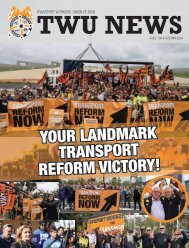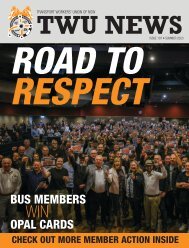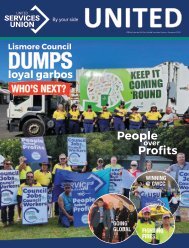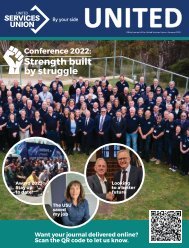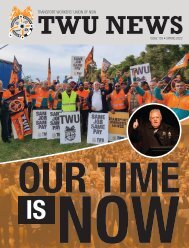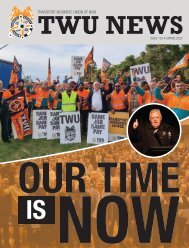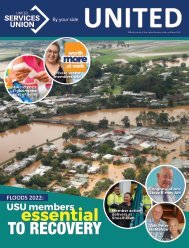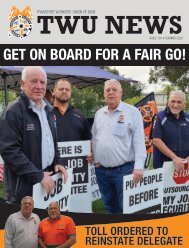United magazine Winter 2016
The official journal of the United Services Union
The official journal of the United Services Union
Create successful ePaper yourself
Turn your PDF publications into a flip-book with our unique Google optimized e-Paper software.
BEEN HURT IN A CAR ACCIDENT?<br />
IN CLAIMING COMPENSATION<br />
injuries sustained by drivers involved in<br />
single vehicle accidents, where it can be<br />
shown the driver was not at fault. This<br />
was confirmed in December 2015, in the<br />
Supreme Court case of Melenewycz v<br />
Whitfield.<br />
This case concerned a motorbike<br />
rider travelling on an outback<br />
road, who was hit by a kangaroo at<br />
considerable speed. The rider suffered<br />
significant injuries as a result and<br />
brought a claim for compensation<br />
against the owner of the motorbike,<br />
claiming the incident was a blameless<br />
motor accident.<br />
The CTP insurer disputed the<br />
incident was blameless, arguing it was<br />
impossible for the blameless provisions<br />
to apply to an injured driver in a single<br />
vehicle accident (with only one driver<br />
involved, who else could be to blame?)<br />
They also argued the rider had been<br />
negligent by not keeping a proper look<br />
out whilst riding and for driving too fast<br />
along the road (though the rider was<br />
below the speed limit).<br />
The Supreme Court found for<br />
the rider and not the insurer or the<br />
kangaroo in question. The Court did<br />
not accept the insurer’s argument that<br />
the blameless accident provisions<br />
could not apply to injuries suffered<br />
by drivers (or in this case, unlucky<br />
motorbike riders in kangaroo territory)<br />
in single vehicle accidents.<br />
While Justice Hamill conceded that<br />
this case “could only have taken place<br />
in Australia”, its significance should<br />
not be underestimated. The insurer<br />
appealed and the Court of Appeal has<br />
heard the argument and its decision is<br />
reserved. So watch this space.<br />
Michael Barnes,<br />
Partner<br />
PRACTICAL ADVICE<br />
IF YOU ARE INJURED IN WHAT YOU BELIEVE TO BE A MOTOR ACCIDENT,<br />
YOU SHOULD:<br />
Take down details of time, date, and location of the accident, and<br />
e<br />
how the accident occurred. Note the make and registration of any<br />
cars involved, as well as the name of any drivers or witnesses. It is<br />
important to identify the “at fault” driver, but there are provisions in<br />
the Act for situations where identifying the driver is impossible (e.g.<br />
where the driver does not stop or bounds away from the scene)<br />
These details will help you identify the Compulsory Third Party insurer<br />
of the vehicle you consider to be at fault. It does not matter whether<br />
it is the owner or the driver of the vehicle who is at fault, what is<br />
important is identifying the CTP insurer for the vehicle which is at fault.<br />
Call and report the accident and your injuries to the Police, who<br />
hopefully will attend the scene. If you are unable to contact the<br />
Police at the time of the accident (e.g. you don’t have mobile phone<br />
reception) you should report the accident at a police station as soon<br />
as possible, and certainly within 28 days. Make sure to get an Event<br />
Number.<br />
Complete and submit a CTP claim form to the CTP insurer for the<br />
vehicle you consider to be at fault. This form will require some<br />
documentation to be attached (e.g. a medical certificate and a<br />
diagram of how the accident occurred) and needs to be lodged within<br />
six months of the accident. The appropriate forms can be found on<br />
the Motor Accident Authority website.<br />
If you fail to lodge a claim form within 6 months you will need to<br />
provide what is broadly called a “full and satisfactory explanation” for<br />
the delay, which can be a time-consuming and potentially expensive<br />
exercise.<br />
Seek early legal advice. Motor accident compensation is a technical<br />
and complex area of the law, which can be difficult to understand and<br />
navigate. The relevant CTP insurer is not acting for you and certainly<br />
the driver of the vehicle which you consider at fault is not interested in<br />
assisting you to make sure you receive the right compensation.<br />
If you or someone you care about has been injured in a motor accident,<br />
“hop” on the phone and speak to Michael Barnes, Peter Lleonart, or Scott<br />
Dougall of Carroll & O’Dea Lawyers to discuss your potential entitlement to<br />
compensation.<br />
q<br />
D<br />
8<br />
CALL US FOR A NO OBLIGATION CASE EVALUATION ON OUR TOLL-FREE<br />
NUMBER 1800 816 559.<br />
<strong>United</strong> <strong>Winter</strong> <strong>2016</strong> • 23




